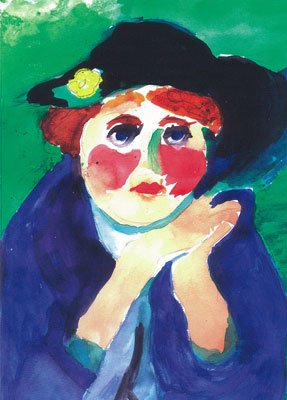Expressive Arts & Art Therapy
For many elders, this stage of life provides the opportunity to enjoy being creative from art and the use of color, to writing, performing arts, music and poetry groups, storytelling, and the myriad of ways we humans show this innate desire to express ourselves. AgeSong Institute weaves psychotherapy, emotional care, and life coaching into these experiences to unearth deeper feelings.
Some elders encounter difficulty forming and expressing linear verbal communication, but that does not mean that there are not other intelligent language forms that work. Without a mode of expression, a person’s “voice” is lost. By exploring different ways of communication, the Expressive Arts Program helps elders be heard, giving a voice to those who do not have the “normal” means to speak.
Dance
It all started when my Daddy used to
throw me quarters to do the Charleston.
The blackbottom, the two step,
One step, two step, like that
that’s how I got started.
I think about the good times I had
in the dance halls on Fillmore or Divisadero.
Oh, how I miss it!
That music gets goin’ and you just can’t take it.
Duke Ellington, Ella Fitzgerald
that jazz music.
Good music ain’t as plentiful as it was before.
When it got started, we shuffled on down to the dance floor
They liked the way I moved
mambo, samba, I dance.
Heels, not too high
they’d say
Hey, hey, hey who is she?
Some women would hate me
amazed and surprised by my dancing.
And I would just smile
The music was inside me, you just gotta keep up with the music that’s all.
Oh, how I miss it!
I dance a little bit now if I hear the right music.
All by myself,
I do a little mambo at night
if they don’t catch me.AgeSong at Hayes Valley Residents, 2006
Drama therapy is one example of the non-traditional ways we use to communicate with elders. For instance, if a resident continually refers to an intern as his brother, the intern might act as the brother to move them along in this train of thought. Through this approach, a story may develop and through that story, unfinished issues can be explored.
Anin Untigaard, Clinical Director for AgeSong Institute, says “It’s like jazz. If you understand the theory, you can create a song that hasn’t been created before. Similarly, if you know how to use the arts in a therapeutic way, you can mold an exercise or method specifically for an individual and his or her unique personality.”
Thank you for making cards from some of the designs my mother painted while she was visiting AgeSong. While they may not seem so extraordinary in the whole scheme of things, I think those cards have become for my mother a visible sign of the life she could have and a real validation of herself as an artist. She has put the cards out, she shows them to everyone, she’s proud of them, and when she talks about them she talks about the “artistic people” she was so happy to meet. I’m hoping artwork will always be something she can come back to and be happy doing. Thank you so much for giving her that.”
Kirsten Moy (daughter of AgeSong resident)



